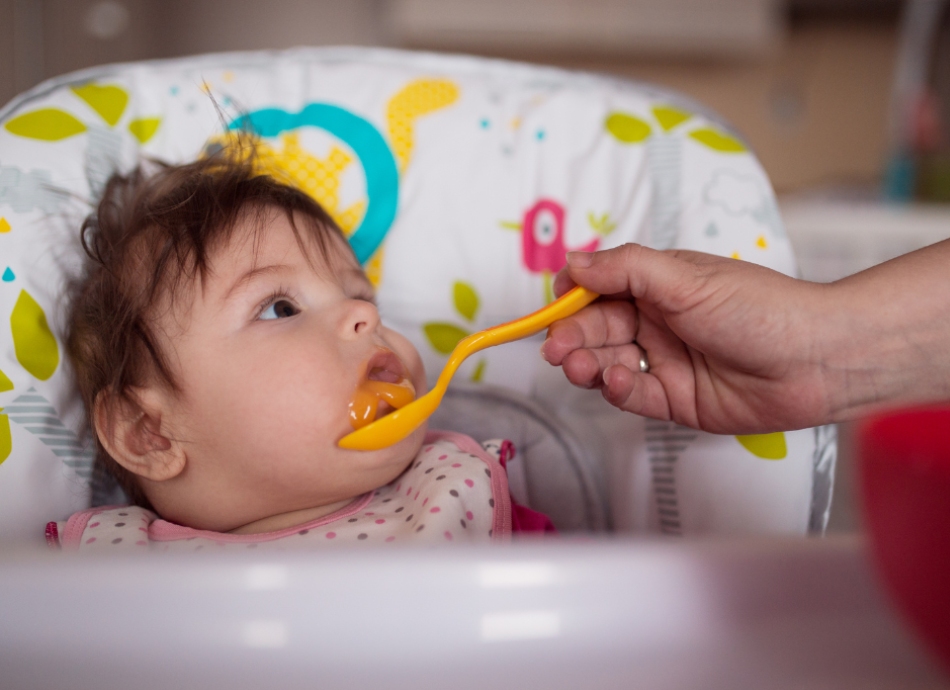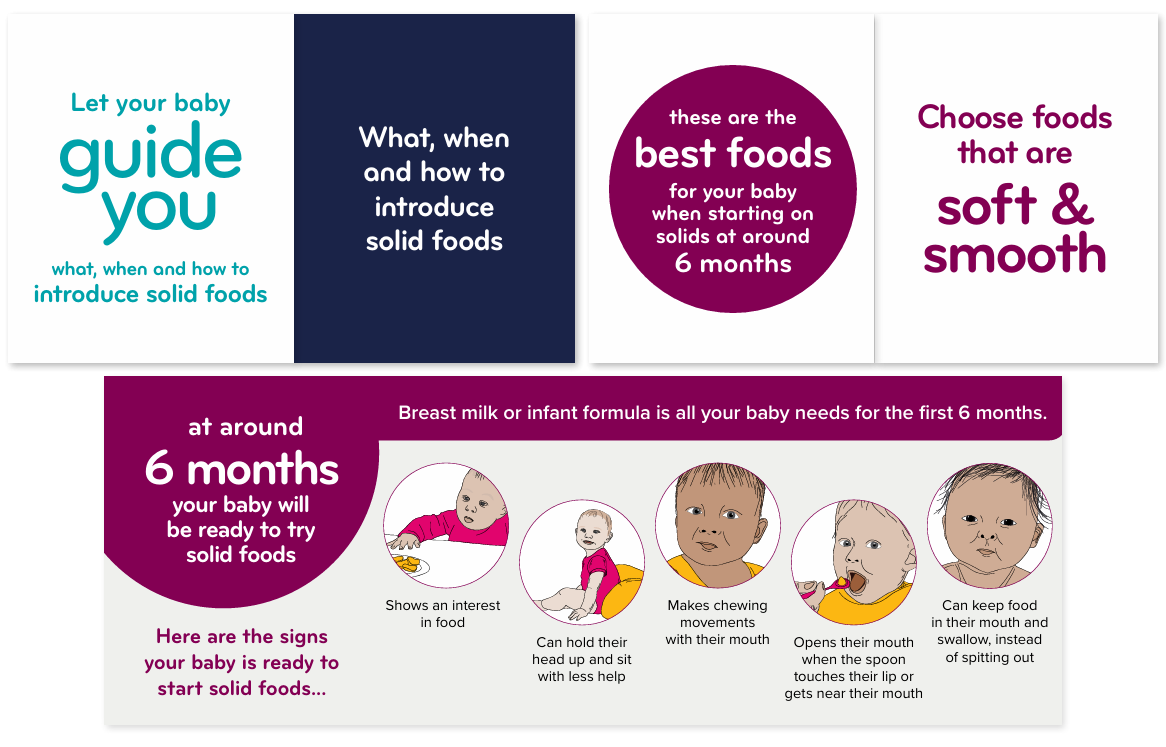Wishing everyone happy holidays and a joyful New Year from the Healthify team. Don't forget to Slip, Slop, Slap and Wrap!
Baby – starting solids
Key points about starting your baby on solids
- Starting your baby on solids can be an exciting, fun and interesting time.
- Your baby is likely to show signs when they are ready to start solids.
- Your baby will be learning new tastes and textures.
- You can help them enjoy this by knowing what to introduce when.

Your baby may be ready to start on solid food at around 6 months of age. They are likely to show signs that they are ready to start solids, such as they:
- seem hungry after breast milk or formula feeds
- can hold their head up well
- are interested in watching you eat, eg, reach out, open their mouth when you’re eating and put their hands and toys in their mouth
- make chewing movements
- easily open their mouth when you touch their lip with a spoon or bring food to their mouth, and don’t stick their tongue forward to push the food out.
Around 6 months, your baby starts to need the extra vitamins and minerals (especially iron and zinc) that are in solid foods, but breast milk and/or formula are still important.
Video: Starting your baby on solids: Key messages
This video may take a few moments to load.
Knowing which foods to feed your baby and when can help you make the transition from a milk-only diet to solids with confidence.
Video: What foods should I choose when starting my baby on solids?
This video may take a few moments to load.
When starting solids at around 6 months of age, start with one food at a time, and add a new food every 2-4 days. Start with 1-2 teaspoons once a day, and slowly increase.
Video: What food should I give my baby at around 6 months?
This video may take a few moments to load.
By the time your baby is around 7 or 8 months old, you can include more variety and texture. Try mixing less popular foods in with more popular ones to encourage your baby to accept a wide variety of foods.
Video: What food should I give my baby from 7-8 months?
This video may take a few moments to load.
By the time your baby is 12 months, they're ready to eat a little of what the rest of the family is eating.
Video: What food should I give my baby from 8-12 months?
This video may take a few moments to load.
Safety is important when your baby is eating. An adult needs to stay close and watch to deal with any problems like choking or a reaction to food. Never leave your baby alone with food.
Video: How to keep your baby baby safe when they are eating
This video may take a few moments to load.
The best drink for babies from birth to 6 months is breast milk (or formula, if breast milk is unavailable). Breastfed babies don't need anything but breast milk for their first 6 months.
Video: What are the best drinks for babies?
This video may take a few moments to load.
Eating solid food is a new experience for your baby. Here are some things to consider when starting solids.
- Offer solids when your baby is most relaxed and happy.
- Hold your baby while you feed them or sit them in a baby high chair.
- Use a small teaspoon and put the food in the middle of their tongue.
- Start with small amounts – a half to 2 teaspoons at first, then slowly increase the amount until your baby is having about 3–4 teaspoons at a meal.
- Your baby may spit out their first solid foods as they learn to get the food to the back of their mouth to swallow it. Be patient and give them time.
- Try one new food every 2–4 days. If they don't like the food the first time, wait a few days and try again with a smaller amount.
- Throw away any uneaten food left on your baby's plate.
Types of foods
Your baby’s first foods need to be plain, smooth and soft. Babies like the plain taste of milk, so first foods also need to be plain. Don't add salt, sugar or other sweeteners, soy sauce, cream, butter or margarine to your baby's food.
Don't give your baby honey. It may contain bacteria that can make young babies sick. Homemade food can be frozen in ice cube trays and used in the next 3–4 weeks.
The following are examples of the best solid foods to start feeding your baby. To puree baby's food, use a blender or push food through a fine sieve.
| Food | How to prepare |
|---|---|
|
Cereal or rice |
Use iron-fortified baby rice or infant cereal. Ensure the cereal you choose is suitable for your baby's age. Prepare the cereal using breastmilk or infant formula as per the instructions on the package. You can also puree plain cooked rice or feed your baby congee. |
|
Vegetables |
Cook and puree vegetables. Remove skins on vegetables such as kumara, potato and pumpkin. Legumes such as peas, lentils and chickpeas must be well cooked and pureed. |
|
Fruits |
Remove the skins, pips or seeds from fruit. Puree the fruit. Cook to soften if needed. |
|
Meats |
You can introduce cooked and pureed chicken, fresh fish, lamb, beef or pork. Do not give salty meat such as corned beef or tinned fish as first foods. |
As your baby gets used to eating solids, you can introduce different types and textures of food, such as mashed foods and finger foods. Your baby is likely to show signs that they are ready for these changes if they:
- can sit without support
- are learning to bite and chew
- can pick up and bring food to their mouth
- can keep thick puree's in their mouth.
Types of foods
| Food | How to prepare |
|---|---|
| Dairy | You can introduce soft cheese such as cottage cheese, custard and plain yoghurt (without added sugar). |
| Vegetables and fruits | Introduce mashed well-cooked vegetables and fruit. Mash cooked legumes. Remove stalks and 'stringy bits' from foods like silverbeet, puha and bok choy. |
| Meats | Continue to puree cooked chicken, fish, lamb beef or pork. |
| Finger foods | You can offer finger foods in pieces that can be easily picked up by your baby, such as very soft fruit and vegetables (ripe banana, well-cooked pumpkin), toast fingers and thin slices of cheese. |
Give your baby solids before their milk feeds. Your baby may be ready for more textures and lumpy foods.
Your baby is likely to show signs that they are ready for these changes if they:
- are learning to crawl or can pull themselves up to stand
- can bite well and chew soft lumps
- are interested in a range of foods and textures
- want to try eating by themselves with need some help from you.
Types of foods
| Food | How to prepare |
|---|---|
| Dairy | Add chopped fruit to yoghurt or custard. |
| Cereal | Offer breakfast cereal such as porridge, wheat biscuits and infant muesli. |
| Vegetables and fruits | Try mashed vegetables mixed with minced or finely chopped tender cooked meat, chicken, fish, egg or lightly mashed cooked legumes. You can also add chopped up noodles, pasta or whole rice. |
| Firmer finger foods | Introduce slightly firmer finger foods such as:
|
Related topics
Resources
Starting solids(external link) Health Promotion Agency, NZ, 2021
Eating for healthy babies & toddlers(external link) HealthEd, NZ, 2021
Let your baby guide you – what, when and how to introduce solid foods(external link) Health Promotion Agency, NZ, 2025
How to introduce solid foods for allergy prevention(external link) Frequently Asked Questions (FAQ) Australasian Society of Clinical Immunology and Allergy, 2024
Baby's first foods(external link) Plunket, NZ
What are good first foods for my baby?(external link) Healthy Kids, NZ
Higher choking risk foods for children under 5(external link) Health New Zealand | Te Whatu Ora
Brochures

Let your baby guide you – what, when and how to introduce solid foods
Health Promotion Agency, NZ, 2015
 How to introduce solid foods for allergy prevention Frequently Asked Questions (FAQ)
How to introduce solid foods for allergy prevention Frequently Asked Questions (FAQ)
Australasian Society of Clinical Immunology and Allergy, 2024
Credits: Healthify Editorial Team
Reviewed by: Cara Hafner, Registered Nurse and Lactation Consultant, NZ Breastfeeding Alliance, Christchurch
Last reviewed:
Page last updated:






